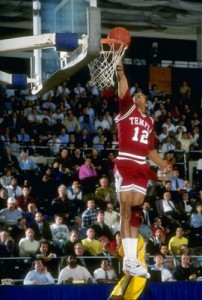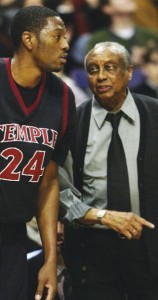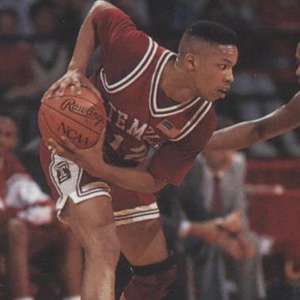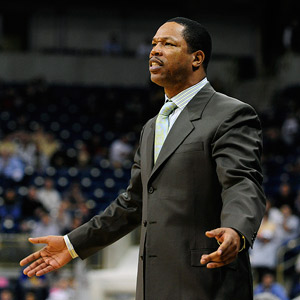Past Imperfect: The Best Temple Team There Ever Was
Posted by JWeill on February 25th, 2011Past Imperfect is a series focusing on the history of the game. Every Thursday, RTC contributor JL Weill (@AgonicaBoss | Email) highlights some piece of historical arcana that may (or may not) be relevant to today’s college basketball landscape. This week: what could have been for the 1987-88 Temple Owls.
It wasn’t as if they needed that much help. After all, they’d won 32 games the previous season. The Temple Owls had three senior co-captains and a junior starter. And of course they still had Coach, whose no-nonsense basketball lessons made magic, even as they frustrated opponents and occasionally his own players alike. But when a player possessing such rare gifts as Mark Macon does comes along, you don’t say no, and you don’t toss him on the bench. Macon was a breakthrough recruit for John Chaney – the crusty, controlled Temple head coach – who knew by the time Macon showed up on campus what he had been sent, and he rightly treated the freshman accordingly.
“People ask why we allow Mark to do so much,” Chaney told Sports Illustrated in 1988. “No one asked why Kansas threw the ball to Wilt the minute he stepped off the plane. Mark’s our breakdown guy. He can beat you creating, with the dribble or the pass. He knows the game. He’s simply the best at his age I’ve ever seen.”
For a man whose idea of compliments means letting you only run gym stairs and not wind sprints, this was glowing praise indeed. But the kid deserved it. You’d never think a 32-win team would have a missing piece, but Macon was that piece. His scoring, his quickness, his levelheaded production, was what turned a good Temple Owls team into the best team in America for most of the 1987-88 season.
But he was also, when the end came, even as a freshman, the one on whose shoulders fell the blame, if not from his team and his coach, then from the assembled masses watching in the arena and at home on TV. Fair? No. But as Chaney, or Macon, will tell you, life isn’t about fair. It’s about work.
No one gave John Chaney much of anything; he took it or worked for it. Some of that was just his personality, but much of it was growing up at a time when young black men weren’t given anything but grief and a whole lot of ‘No.’ That’s what Chaney found out when his family moved to Philadelphia when he was just 14. Quiet and scared, embarrassed about his clothes and his Florida drawl, Chaney was just another poor black kid with no confidence and no future in a sea of such struggles, and with a home life that left him questioning everything. But Chaney was lucky in that he found something to believe in, and more importantly, to make him believe in himself. And it wasn’t a woman and it wasn’t a job and it wasn’t a favor. It was basketball.
Basketball made Chaney a man because Chaney made basketball a war: with himself and with whoever tried to take it from him. As many stories abound about Chaney’s temper and anger as do about his immense ability to play and coach the game. There’s the one about him literally tackling someone who beat him twice with the same move. There’s the one about him spinning a tray of glasses of water on one hand while dribbling with the other. The one about how he broke someone’s ankle who tried to swipe the ball from him. And the one where he threatened to kill an opposing coach. OK, the last one we all saw. But the others: Tall tales? Hard to say now, because there are nuggets of truth in them. Then, too, there are some facts: Philadelphia Public League MVP; 2,000-point collegiate scorer; NAIA All-American; Eastern Basketball Pro League MVP; Division II national championship-winning coach. And then these facts, too: no scholarship offers from the Big 5; No NBA interest after college; No Division I coaching jobs until 1982.
But Chaney never bowed, maybe because despite the hard luck, the bad politics, the injustice, how he took it was that nothing less than perfection would be acceptable, whatever the reason. He took all those hard lessons he learned and put them squarely in his heart. And now he would do the same for kids at Temple, for kids – often black, poor, fatherless, scared like he was once – who needed some lessons in what was going to be given and what was not.
Because of his toughness, his sheer meanness at times, some folks have often misunderstood his intensity as recklessness, his frustration at what he sees as racial injustice as a confused racism, his gruff exterior as his whole person. But they’re just reading things the way people always do: from the outside. From the inside, Coach is just doing what he is supposed to do. He’s teaching kids about life, and about basketball. Because for Chaney, there isn’t one without the other.
And the thing is, his Temple team in ’88 wasn’t a surprise. Or shouldn’t have been. Since Chaney led the team to a 14-15 record in Year 1 after taking the reins of the program in 1982, the Owls had gone 108-21. They’d gone a silly 65-7 in a good Atlantic 10 conference in that span. The man who’d waited his turn to get a chance at big time basketball wasn’t going to sit around and let others dictate his success or failure. It’s how he taught his teams to play: under control, with possession, with no emotion, all business. It’s how he lived. It’s how they would learn to live, too.
It’s how his boys got those 5 A.M. practices. It’s how they got “one-slip and you’re out” rules. When you’re given a second chance – or even a chance at all – you don’t go goofing around, you don’t mess it up. A free education isn’t something you mess around with. A free education was what made Chaney wake up, made him understand that being serious about life isn’t a choice, really. You’re either going to be serious or you’re going to be nothing.
Mark Macon had every intention of being serious. It was how he learned the game under his high school coach, Norwaine Reed, a Chaney-like figure whose dedication to team and to the “right way” molded Macon into the kind of kid who could walk onto campus ready to score 20 points a game on the nation’s best team. This was almost unheard of stuff at the time, especially for a guard.
In many ways, Macon was a milestone for Chaney. The first All-American recruit for the guy who turned nobodies into somebodies and somebodies into stars. But Macon wasn’t one of those coddled kids who’d been told he was The Man from Day 1 and swallowed it whole. He was more so the kid who was told he was The Man and was then told to run extra sprints, or even volunteered to. In other words, John Chaney’s kind of kid.
It wouldn’t take long for the kid’s preternatural gifts to show themselves, no further than the season opener. Macon scored 22 with seven boards in a win over UCLA with legendary Bruins coach John Wooden watching close by. But it wasn’t just the numbers that impressed; it was the ease with which Macon fit into the college game. Even for the most talented high school players, the step up mentally from the prep ranks is usually on a learning curve – for some steeper than for others. Macon, it appeared, had no learning curve at all. There are reasons that help explain it.
Macon naturally benefitted from having a posse of experienced, pro-caliber players around him. Every pick that senior center Tim Perry set had been drilled over and over, enough so you know Macon didn’t have to wait to see if he was open to pop and shoot. Every pass Macon received from Howie Evans was coming from the school’s all-time assists leader. Every time the defense doubled Ramon Rivas in the post, Macon knew he’d be clear when the ball came back to him. Of course, Macon still had to make the shots. A vast majority of the time, he did. The very few times he didn’t, of course, there was trouble.
With announcers wantonly dubbing Macon a young Oscar Robertson, Temple won 14 straight before tasting defeat, a one-point loss in the annual grudge match with UNLV in which Chaney had called up a last-second play to get Macon a shot to win it, only to watch as the pass slipped through his star’s hands. That loss left Temple angry and frustrated that they’d let someone else finish the game for them. They vowed it wouldn’t happen again.
And there would be no more screw-ups until the end. With those three seniors, junior shooter Mike Vreeswyk and the precocious Macon, there was too much experience and too much Chaney flowing through the veins of the players on the court to lose. It was all about execution and control. You don’t get too up because you never know when down is coming. You don’t get too down, because everyone gets up sometimes. Control. Possession. No emotion. The kind of thing you learn when you work hard and don’t talk junk and do your job, the kind of thing you learn when no one expects you to succeed but you do. Exactly what you learned if you were John Chaney.
As Vreeswyk said, “We don’t play on emotion, because it only lasts a few minutes. Our challenge is always against the game itself and not a particular opponent.”
Temple kept meeting that challenge, regardless of opponent. So much so that the Owls didn’t drop a game for the rest of the regular season and the conference tournament. Only a handful of close calls, as a matter of fact. When the smoke cleared and the NCAA brackets were announced, Temple was No. 1 with just the lone loss to Vegas. But what had occurred in that loss – even if no one knew it at the time — had been an omen. Against Vegas, Macon, while brilliant much of the game overall, had shot just 9-of-22. He’d played stellar defense, made good passes and kept his team in the game, but his shooting woes had put Temple in a position to lose. Despite the presence of those three senior leaders, it was clear that as its star freshman went, so went the Owls. And Macon was a scorer as much as a shooter. And scorers get streaky, and when they get streaky, they keep on firing.
Of course, none of that was apparent when Macon put 18 on the board in the first half of Temple’s NCAA opener. Nor when Perry poured in 17 of Temple’s 18 in a pull-away run that began after Lehigh had closed to within two. Things were rolling. The pieces were there. Chaney had put together his ideal team: more like a family. Older kids help the younger ones, but the younger ones have that special “it.” And father running things, caring but tough and firm. That’s the team Lehigh got, just like most every team had during the regular season. It was the same group Georgetown saw in a second round rout. And Richmond the round after.
But even if a family doesn’t always see or acknowledge its flaws, they’re still there. Every family has them. Those times when no one will question things because they aren’t supposed to, or when the one who should doesn’t. Or can’t. When this happens, the inevitable occurs. For Temple, who had ridden its prize colt, its coach-in-freshman-form, there was no choice but to let the reins go when things weren’t so rosy. It’s what had gotten them that far.
The 1988 East Regional Final, played in the Meadowlands, was tough to watch, even if you weren’t a die-hard Temple fan. Now imagine how it felt if you were. While many may forget it now, Temple has a proud history — still the sixth winningest team ever. Hal Lear. Guy Rodgers. Harry Litwack. History. Whether Macon knew it or not before he arrived, he’d be well versed by the time he left, just like the others before and after him. Chaney had grown up 10 blocks from that history. He understood history was who made it and who wrote it. But sometimes, at the worst times, at the most helpless times, you can’t help wonder if history isn’t just what it too often seems like is: just what happens. Wouldn’t it rest the soul to feel like the shot that didn’t go in wasn’t ever supposed to go in. It wasn’t an errant flick of the wrist or a wayward sense of hero purpose, but rather just the fates intervening. Would be nice to feel that way, probably.
There was nothing resembling such solace on the face of Macon as he sobbed in the aftermath of a memorable 6-for-29 performance in Temple’s loss to Duke in the Elite Eight of the ’88 tournament. The nation tuned in as Macon hoisted shot after shot in vain hopes of righting what was going astray, all the while being draped by Billy King, the nation’s best defender. It seemed there was nothing Macon could do about it. The harder he tried, the worse it got. And he wasn’t alone. The Owls, after all that winning, after all that control, finally surrendered it. Leading at the half, but struggling, Temple went cold for a long stretch in the second frame, and that was all it took.
In basketball, as in life, there are those moments where you realize that it’s just not going to happen, whether by result alone or by faith, it doesn’t really matter. Who knows if in Chaney’s heart there was still hope until the end. He won’t say anything about things like that. It didn’t seem like there was from the comforts of television distance. It seemed like what it probably was: a team of kids who’d done everything that was ever asked of them and whose efforts were not going to matter in the bitter end. All that control wasn’t going to get them what they’d thought it was going to. Cruel, but life. There were other teams going home who were of the same cast. That’s a big part of the story of the NCAA tournament, even if it isn’t always addressed as such. That doesn’t make it less awful, just better understood.
But for all the talk of a freshman and the old man, it was the end of the road most for three seniors who’d given themselves to building something lasting in the Temple program. And they did just that. In the aftermath, Temple became a place where potential wasn’t just a commodity but a precious one. A place where ultimate victory seemed not only possible but — with the kind of maximum effort and resilience preached by Chaney — attainable. Few programs off the big conference trail get to that stage, and even fewer maintain it. Temple did both with Chaney in charge.
With his cover gone, Macon would soon learn the other side of being the Man, spending the next three seasons in a seemingly endless run of box-and-one, gimmicky chase defenses. And while he’d rise and fall, he’d ultimately break through struggles because he never wavered in his focus and dedication to the teachings he’d learned back in Saginaw and in John Chaney’s House of Basketball. Not just the ones about the pick-and-roll and playing arms-up, head-up defense, but the ones about being something, about being someone. If you were one of those guys, one among the family, it wasn’t something you’d easily forget. Just wasn’t possible. Macon certainly didn’t.
Don’t believe me? Just ask the players at Binghamton, where Coach Macon now hands down the lessons.















































It’s nice to see great writing like this on a college basketball blog. RTC has consistently well-written posts, but a story like this – and it is a story, not just a stats analysis or morning-after on a game – is really impressive. It really imparted all the emotion and hope associated with the hard work and rise to fame before the eventual, ultimate letdown of the Duke game. I enjoyed reading, thank you!
Great article! Mark Macon was one of my favorites back in the day!